Coins of the Australian pound
Federation in 1901 gave the Commonwealth a constitutional power to issue coins and removed this power from the States. However, British coins continued in use until 1910, when Australian silver coins were introduced. These included florins, shillings, sixpences and threepences. They had a portrait of King Edward VII on one side. Australian pennies and half-pennies were introduced into circulation the following year. In 1931 gold sovereigns stopped being minted in Australia. A crown or five-shilling coin was minted in 1937 and 1938.
Australian £sd
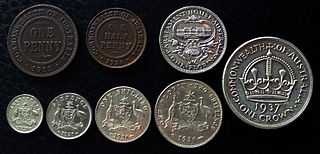
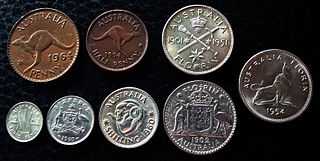

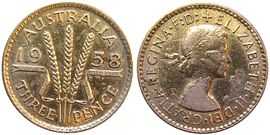

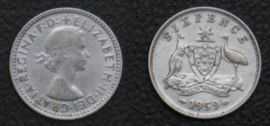
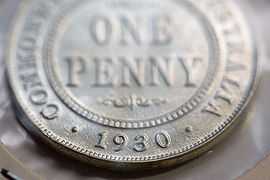
In 1898 the British government allowed two colonies, New South Wales and Victoria, to mint silver and bronze coins at their mints in Sydney and Melbourne respectively.
Revaluation
In 1947, due to costs incurred during WW2, the silver content of the coins was reduced from 0.925 to 0.500 of the coin weight, which lasted until decimalisation on 14 February 1966. One coin highly sought after by collectors is the 1930 Penny. Its rarity is so well known amongst Australians, that demand for what is akin to a blue chip investment has pushed prices to approximately $26,000 Australian dollars for an average standard example. A proof example of the same coin recently changed hands for over $620,000 Australian dollars, making it the most expensive copper coin in the world.
Coins
- Half Penny (½d)
- Penny (1d)
- Threepence (3d)
- Sixpence (6d)
- Shilling (1/-)
- Florin (2/-)
- Crown (5/-)
| 1910 Series | |||||||
|---|---|---|---|---|---|---|---|
| Value | Diameter | Weight | Composition | Edge | Obverse and Title | Reverse | Minted Year |
| 3 pence | 16 mm | 1.41 g | 92.5% silver 7.5% copper | Plain | EDWARDVS VII D: G: BRITT: OMN: REX F: D: IND: IMP: | 1908 coat of arms | 1910 |
| 6 pence | 19mm | 2.82 g | Reeded | ||||
| 1 shilling | 23.5 mm | 5.65 g | |||||
| 2 shillings = 1 florin | 28.5 mm | 11.31 g | |||||
| 1911 Series | |||||||
|---|---|---|---|---|---|---|---|
| Value | Diameter | Weight | Composition | Edge | Obverse and Title | Reverse | Minted Year |
| ½ penny | 25.5mm | 5.67g | Bronze(97% copper, 2.5% zinc, 0.5% tin | Plain | GEORGIVS V D. G. BRITT: OMN: REX F. D. IND: IMP: | Value | 1911 – 1936 |
| 1 penny | 30.8mm | 9.45g | |||||
| 3 pence | As previous series | 1908 coat of arms | |||||
| 6 pence | |||||||
| 1 shilling | |||||||
| 2 shillings = 1 florin | |||||||
| 1937 Series | |||||||
|---|---|---|---|---|---|---|---|
| Value | Diameter | Weight | Composition | Edge | Obverse and Title | Reverse | Minted Year |
| ½ penny | Bronze | GEORGIVS VI D: G: BR: OMN: REX F: D: IND: IMP: | Value | 1938 – 1939 | |||
| ½ penny | Kangaroo | 1939 – 1948 | |||||
| 1 penny | 1938 – 1948 | ||||||
| 3 pence | As previous series | three stalks of wheat and a ribbon | 1938 – 1944 | ||||
| 6 pence | 1908 coat of arms | 1938 – 1945 | |||||
| 1 shilling | Merino ram's head | 1938 – 1944 | |||||
| 2 shillings = 1 florin | 1912 coat of arms | 1938 – 1945 | |||||
| 5 shillings = 1 crown | 28.28 g | 92.5% silver 7.5% copper | Milled | Crown | 1937 – 1938 | ||
| 1945, 1949, 1953, 1955 Series | ||||||||
|---|---|---|---|---|---|---|---|---|
| Series | Composition | Obverse and Title | ½d | 1d | 3d | 6d | 1s | 2s |
| 1946 | 50% silver, 40% copper, 5% zinc, and 5% nickel | As previous series | None | None | 1947, 1948 | 1946, 1948 | 1946, 1948 | 1946, 1947 |
| 1949 | ½d & 1d as 1937 series, the rest as previous series | GEORGIVS VI D: G: BR: OMN: REX FIDEI DEF | 1949 – 1952 | 1950 – 1952 | 1951 – 1952 | |||
| 1953 | As previous series | ELIZABETH II. DEI GRATIA REGINA | 1953 – 1955 | 1953 | 1953 – 1954 | |||
| 1959 | ELIZABETH II. DEI GRATIA REGINA F: D: | 1959 – 1964 | 1955 – 1964 | 1955 – 1963 | 1956 – 1963 | |||
See also: Half penny, Penny, threepence, sixpence, shilling, florin, crown.
Pre-decimal commemorative coins
Florin = 2 shillings
-
1927 Australian florin commemorating the opening of the original Parliament House
-
1934-35 Australian florin commemorating the centenary of Victoria and the establishment of Melbourne
-
1951 Australian florin commemorating 50 years of the Commonwealth of Australia
-
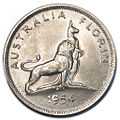
1954 Australian florin struck to commemorate the visit to Australia of Queen Elizabeth II on 3rd Feb 1954.
-
The obverse of the commemorative 1927 Australian florin, with
King George V -
The obverse of the commemorative 1934-35 Australian florin
-
The obverse of the commemorative 1951 Australian florin, with
King George VI -
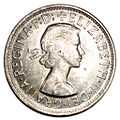
The obverse of the commemorative 1954 Australian florin, with Queen Elizabeth II
References
- Ian W. Pitt, ed. (2000). Renniks Australian Coin and Banknote Values (19th ed. ed.). Chippendale, N.S.W.: Renniks Publications. ISBN 0-9585574-4-6.
- Krause, Chester L., and Clifford Mishler (2003). 2004 Standard Catalog of World Coins: 1901–Present. Colin R. Bruce II (senior editor) (31st ed.). Krause Publications. ISBN 0873495934.
External links
- Cruzi's Coins
- Guide to predecimal coins
- History of Australian coins
- Australia's first coins - State Library of NSW
- Commonwealth Pre-Decimal Currency
- Australian Pre-Decimal Currency
| ||||||||||||||||||||||||||
| ||||||||||||||||||||||||||||||||||||||||||||||||||





